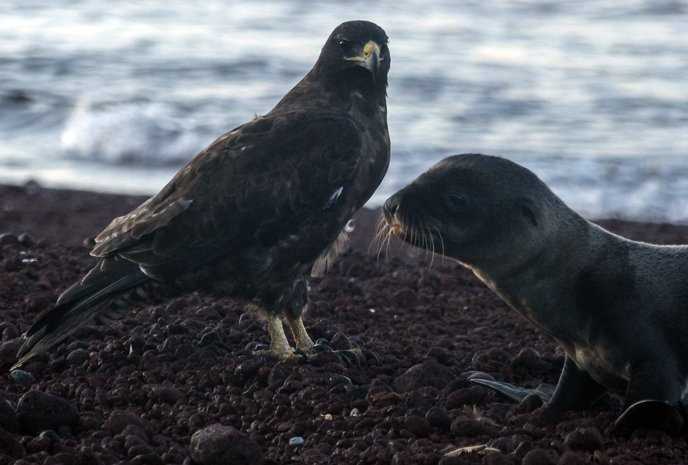After an incredibly full day yesterday – arrival, time-changes, instructions, shore visit – today we kept at it! Here on the equator there are only twelve hours of daylight available to us (unlike our colleagues in Antarctic who seem to get away with twenty-four hours of light!). So fill them with the sights and sounds of Galapagos I will!
We began with an island renowned for its role in movies and documentaries, and also its challenge- more than 370 wooden steps to get to the top! But worth it, all agree. Before breakfast, before the day started to heat up, guests were up at daybreak and ready to go.
Afterwards, snorkeling equipment was distributed and a group went ashore to use the golden sand beach to try out the masks, snorkels, fins to test the water! At under 70 degrees it was chilly at first, but then once we got the hang of it, deep water snorkelers took off!
Several white-tipped reef sharks were spotted, Galapagos penguins zoomed by, and plenty of colorful reef fish were around! I’m frequently asked what will be seen when we go snorkeling and the most honest answer is “fish”! Galapagos has an extremely variable ocean around it. Throughout the year water temperatures can vary by as much as 20 degrees F, not something that reef-building corals can tolerate. So our reefs are made of lava rock, and covered with other marine invertebrates, sponges, tunicates and algae.
Lunch was pretty spectacular in itself today – a feast of Ecuadorian traditional foods from the coast and from the highlands, with tropical fruits and flavors thrown in for good measure.
By the time mid-afternoon rolled around, the National Geographic Endeavour had sailed far and was approaching the island of Rabida, with its red, iron-oxide beach.
Over the next four hours we left the ship for various excursions: deep-water snorkeling where green sea turtles, stingrays, sea lions and white-tipped reef-sharks showed up at one time or another; kayaking along the spectacularly tall red cliffs of Rabida Island and the length of the long, red beach; and a visit on shore for a walk along the magnificent shoreline where a young Galapagos hawk flew down and landed next to us, then proceeded to walk around the small colony of sea lions, and chose to finally visit with a female sea lion who had given birth within the last two days. Her pup was curious as well about this unusual life form that suddenly appeared next to it! As the pup and hawk got closer and closer, we could see the mother keeping a watchful eye on her pup, however in the end, nothing dramatic occurred between them. Only very weak, abandoned sea lion pups are in danger from a Galapagos hawk. There are limitations to the strength of their beaks and small lava lizards, hatchling iguanas, and small land birds are more common as prey items. This situation seemed most likely a case of curiosity unbounded – a young hawk, a young sea lion – both discovering the world.
Finally the sun set over the island of Isabela and we were once more on our way to more adventures…who knows what awaits us tomorrow…









